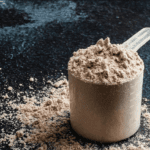
It’s no secret the last ten or so years has seen a diet culture shift that focuses on one “macro,” and that “macronutrient” is protein. Instead of tracking calories, dieters are usually tracking macros now. In the 1980s, fat was villainized as a heart health risk and every processed food advertised “low fat” versions. Carbohydrates have also received the same treatment, with low-carb diets becoming the staple for weight loss. Protein (with the exception of eggs and red meat being blamed for heart disease) has never really been the target of a food smear campaign.
Rebranding Atkins to Paleo:
The real shift in how Americans think about protein may have started when The Atkins Diet of the 1990s got rebranded as Paleo in the early-to-mid 2000s. Along with Paleo, other similar diets caught on — like Carnivore and Keto. While Atkins and its successors are based on extremely low-carb, high-protein regimens, the real change was in how it was marketed. The Atkins Diet “cut carbs,” but allowed foods like bacon.
The more recent diets go further, putting more emphasis on eating a lot of protein rather than just avoiding carbs. Promoters of these diets are constantly saying things like “make sure you don’t lose muscle mass” and “make sure you get enough protein.” It encourages not just eating protein, but over-consuming it, often including bacon and red meat, and turns high protein intake into the new standard.
Masculinity, Meat, and the Influencer Effect
These diets also share similar branding — a kind of Joe Rogan-esque logic that men (and women) used to be cavemen, so that’s how they should eat. It speaks to a fantasy of being a wild hunter eating large animals, while rejecting modern reality. The fact is: regular lifting at the gym doesn’t require excessive amounts of protein.
There’s also a kind of rejection baked into this packaging — a rejection of processed foods, calorie counting, and complicated food systems. It taps into a desire for “real food” and a simpler way of eating.
The mindset around these “Joe Rogan” diet types is often about returning to a rugged simplicity. Generally, these trends are more popular among men, while other diets like the Mediterranean Diet appeal more to women. One small study showed that men who ate more meat perceived themselves as more masculine.
Podcasters like Rogan, Huberman, and Attia have brought these diets to massive audiences of mostly men — but it spills over to women too. For example, tallow is trending as a facial moisturizer beauty product, and women are frequently coached to increase protein consumption to lose weight. Brands like RYSE use flavors like raspberry and pastel packaging to target a female audience.
What the podcasters and influencers are missing is that cavemen weren’t bulking up on cows, bison, bacon, and many hard boiled eggs a day. Many of the protein recommendations coming from “fit-fluencers” require people to eat a challenging amount of protein every day. This kind of messaging creates a profitable business in supplements and powders to help people hit those numbers.
The Market for Protein:
High-protein eating has become what many Americans now think health looks like. Nearly every food label advertises that it contains protein. A 2024 survey of 3,000 people found that 71% were trying to eat more protein. And yet, very few Americans (even vegans) actually have a protein deficit.
Still, the market for protein supplements is booming. In the U.S., it’s currently worth $9.88 billion and expected to reach about $22 billion by 2030. In Europe, by comparison, the market is $1.44 billion, expected to grow to $2.3 billion — showing just how protein-obsessed the U.S. really is.
Sellers of protein supplements advise that getting “enough” protein not only helps with weight loss and muscle mass, but everything from immunity, heart health, and longevity.
How CrossFit Changed The Game:
Another trend that contributed to this was the rise of CrossFit and similar brands. CrossFit changed the culture of fitness, even for people who never stepped foot in a class. Before CrossFit, people worked out. After CrossFit, everyone became an “athlete.”
Protein brands and fitness influencers play right into that mentality — boosting the consumer’s ego and creating the impression that supplements are necessary for average gym-goers to reach their goals.
In 2009, NYT food columnist Mark Bittman wrote a short piece when he was told his diet could use more protein. He was training for a marathon on a vegetarian diet, and protein hadn’t even crossed his mind. He wrote:
“When Dr. Fernstrom and I looked at my food log, it was clear that my protein intake had indeed been on the low end ‘for an athlete,’ she said. I thought this odd, because I’m not an athlete. But at this level of training (and going forward), she insisted that I qualified. (Yikes.)”
Conclusion:
The high-protein trend doesn’t seem to be going anywhere. It’s now a core part of what Americans think health is. Even though we’re not short on protein, the pressure to “get enough” keeps climbing — and so does the industry built around it.
Next week we will dive into what protein consumption actually does for your body, what the research says (and doesn’t say) about eating protein, and common misconceptions about high-protein diets.


